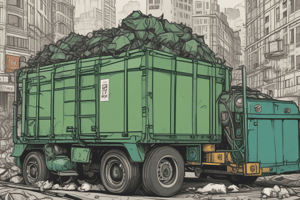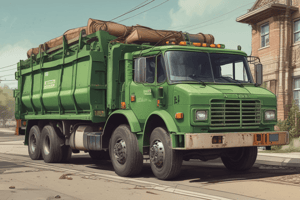Podcast
Questions and Answers
A municipality is looking to reduce its environmental footprint. Which approach aligns best with the waste management hierarchy's primary goal?
A municipality is looking to reduce its environmental footprint. Which approach aligns best with the waste management hierarchy's primary goal?
- Investing in a new, more efficient landfill with advanced leachate collection systems.
- Expanding the city's recycling program to include a wider range of plastic types.
- Implementing a public awareness campaign promoting reusable shopping bags and reduced packaging. (correct)
- Partnering with a waste-to-energy plant to incinerate non-recyclable waste and generate electricity.
A rural community seeks a cost-effective waste management solution primarily for agricultural waste. Which of the following methods would be most suitable?
A rural community seeks a cost-effective waste management solution primarily for agricultural waste. Which of the following methods would be most suitable?
- Shipping the waste to a distant, centralized landfill.
- Developing a community composting program for agricultural residues. (correct)
- Establishing a large-scale incineration plant with energy recovery.
- Implementing a high-tech Mechanical Biological Treatment (MBT) facility.
A city is facing increasing volumes of electronic waste. What strategy would best address both the environmental and economic challenges of e-waste?
A city is facing increasing volumes of electronic waste. What strategy would best address both the environmental and economic challenges of e-waste?
- Loosening regulations on e-waste disposal to encourage more companies to handle it.
- Exporting the e-waste to developing countries for dismantling and processing.
- Incinerating the e-waste to reduce its volume and generate energy.
- Establishing a local e-waste recycling facility to recover valuable materials and safely dispose of hazardous components. (correct)
Which of the following scenarios exemplifies the concept of 'integrated waste management'?
Which of the following scenarios exemplifies the concept of 'integrated waste management'?
Which of the following best describes the purpose of leachate collection systems in modern landfills?
Which of the following best describes the purpose of leachate collection systems in modern landfills?
A manufacturing plant wants to minimize its hazardous waste generation. Which strategy aligns best with the waste management hierarchy?
A manufacturing plant wants to minimize its hazardous waste generation. Which strategy aligns best with the waste management hierarchy?
What is the primary benefit of anaerobic digestion compared to traditional composting?
What is the primary benefit of anaerobic digestion compared to traditional composting?
Which factor most significantly contributes to higher per capita waste generation rates in developed countries compared to developing countries?
Which factor most significantly contributes to higher per capita waste generation rates in developed countries compared to developing countries?
Why is source separation of recyclable materials important for effective recycling programs?
Why is source separation of recyclable materials important for effective recycling programs?
How does effective waste management contribute to mitigating climate change?
How does effective waste management contribute to mitigating climate change?
A community wants to improve its recycling rates but is facing challenges with contamination of recyclable materials. Which of the following strategies would be MOST effective?
A community wants to improve its recycling rates but is facing challenges with contamination of recyclable materials. Which of the following strategies would be MOST effective?
Which of the following is a key challenge associated with incineration as a waste management method?
Which of the following is a key challenge associated with incineration as a waste management method?
What role do waste management regulations play in protecting public health and the environment?
What role do waste management regulations play in protecting public health and the environment?
In the context of electronic waste (e-waste) management, what is 'dismantling' and why is it important?
In the context of electronic waste (e-waste) management, what is 'dismantling' and why is it important?
How can promoting 'circular economy' principles contribute to improved waste management?
How can promoting 'circular economy' principles contribute to improved waste management?
Which of the following exemplifies 'waste minimization' as a waste management strategy?
Which of the following exemplifies 'waste minimization' as a waste management strategy?
A coastal community is experiencing increased marine pollution from plastic waste. Which of the following interventions would be MOST effective in addressing this issue at its source?
A coastal community is experiencing increased marine pollution from plastic waste. Which of the following interventions would be MOST effective in addressing this issue at its source?
What is a primary concern regarding the disposal of ash generated from waste incineration facilities?
What is a primary concern regarding the disposal of ash generated from waste incineration facilities?
A city government is considering investing in 'smart waste management' technologies. Which of the following is a potential benefit of implementing such a system?
A city government is considering investing in 'smart waste management' technologies. Which of the following is a potential benefit of implementing such a system?
Which of these options poses the greatest challenge for effective waste management in developing countries?
Which of these options poses the greatest challenge for effective waste management in developing countries?
Flashcards
Waste management
Waste management
Collection, transportation, processing, recycling, and disposal of waste materials.
Waste collection
Waste collection
Gathering waste from sources & transporting it to facilities.
Waste treatment and processing
Waste treatment and processing
Reduces volume/toxicity, recovers resources, prepares for disposal.
Waste disposal
Waste disposal
Signup and view all the flashcards
Waste Management Hierarchy
Waste Management Hierarchy
Signup and view all the flashcards
Recycling
Recycling
Signup and view all the flashcards
Composting
Composting
Signup and view all the flashcards
Incineration
Incineration
Signup and view all the flashcards
Anaerobic Digestion
Anaerobic Digestion
Signup and view all the flashcards
Hazardous waste
Hazardous waste
Signup and view all the flashcards
Electronic waste (E-waste)
Electronic waste (E-waste)
Signup and view all the flashcards
Integrated Waste Management
Integrated Waste Management
Signup and view all the flashcards
Waste Management Regulations
Waste Management Regulations
Signup and view all the flashcards
Waste Prevention
Waste Prevention
Signup and view all the flashcards
Waste Minimization
Waste Minimization
Signup and view all the flashcards
Energy Recovery
Energy Recovery
Signup and view all the flashcards
Study Notes
- Waste management includes the collection, transportation, processing, recycling, and disposal of waste materials.
- Waste management covers municipal solid waste (MSW), industrial waste, hazardous waste, and electronic waste (e-waste).
- Effective waste management protects public health and the environment, and conserves resources.
Waste Generation
- Waste generation depends on population growth, urbanization, economic development, and consumption patterns.
- Developed countries usually generate more waste per person than developing countries.
- Waste comes from households, commercial establishments, industrial facilities, and construction sites.
Waste Collection
- Waste collection involves gathering waste from sources and moving it to processing or disposal facilities.
- Collection methods depend on population density, infrastructure, and available resources.
- Curbside collection, drop-off centers, and collection events are common collection methods.
Waste Treatment and Processing
- Waste treatment and processing aims to reduce waste volume and toxicity, recover resources, and prepare waste for disposal.
- Common treatment and processing methods:
- Recycling converts waste into new products.
- Composting decomposes organic waste into soil amendment.
- Incineration burns waste to reduce volume and generate energy.
- Anaerobic digestion decomposes organic waste without oxygen to produce biogas and digestate.
- Mechanical biological treatment (MBT) combines mechanical and biological processes to stabilize waste and recover resources.
Waste Disposal
- Waste disposal means the final placement of waste in landfills or other facilities.
- Landfilling is the most common disposal method, but can cause groundwater contamination and greenhouse gas emissions.
- Modern landfills have liners, leachate and gas collection systems to minimize environmental impacts.
- Waste-to-energy facilities and engineered storage are alternative disposal methods.
Waste Management Hierarchy
- The waste management hierarchy prioritizes strategies based on environmental impact and resource efficiency in this order.
- Prevention reduces waste generation at the source through better product design, consumption habits, and initiatives.
- Minimization reduces waste through reuse, repair, and other strategies.
- Recycling collects and processes waste into new products.
- Energy Recovery converts waste into energy through various technologies.
- Disposal is the final placement of waste in landfills or other facilities.
Recycling
- Recycling involves collecting, processing, and converting waste materials into new products.
- Paper, plastic, glass, and metal are common recyclable materials.
- Recycling conserves resources, reduces energy use, and lowers greenhouse gas emissions.
- Recycling programs are used at residential, commercial, and industrial levels.
- Contamination, sorting costs, and market demand are challenges to recycling.
Composting
- Composting is the biological decomposition of organic waste into a nutrient-rich soil amendment.
- Food scraps, yard waste, and agricultural residues are compostable materials.
- Composting reduces landfill waste, improves soil health, and reduces the need for chemical fertilizers.
- Composting can be small-scale (backyard) or large-scale (commercial facilities).
Incineration
- Incineration burns waste at high temperatures to reduce volume and generate energy.
- Modern facilities use air pollution control systems to minimize emissions.
- Incineration can reduce waste volume by up to 90% and generate electricity or heat.
- Air pollution, ash disposal, and incomplete combustion are concerns.
Anaerobic Digestion
- Anaerobic digestion decomposes organic waste without oxygen to produce biogas and digestate.
- Biogas can be used as a renewable energy source.
- Digestate can be used to improve soil as an amendment or fertilizer.
- Anaerobic digestion treats food waste, agricultural residues, and wastewater sludge.
Hazardous Waste Management
- Hazardous waste poses a threat to human health or the environment due to its characteristics.
- Managing hazardous waste properly prevents contamination of soil, water, and air.
- Managing hazardous waste includes identification, classification, proper storage, specialized treatment, and site monitoring.
Electronic Waste (E-Waste) Management
- Electronic waste (e-waste) includes discarded electronic devices.
- E-waste contains valuable and hazardous substances.
- Proper e-waste management recovers materials and prevents pollution.
- E-waste management includes collection, sorting, dismantling, material recovery, and proper disposal of hazardous components.
Integrated Waste Management
- Integrated waste management uses a combination of strategies to achieve environmental and economic goals.
- An integrated system may include reduction, recycling, composting, incineration, and landfilling.
- The optimal mix depends on local conditions.
Waste Management Regulations
- Waste management is regulated at international, national, and local levels.
- Regulations cover waste generation, collection, transportation, treatment, and disposal.
- Waste management regulations aim to protect human health and the environment, plus conserve resources.
Challenges in Waste Management
- Limited infrastructure and resources are a concern, especially in developing countries.
- Public awareness and participation is needed to improve programs.
- Contamination of recyclable materials is a problem
- It can be difficult to find suitable sites for waste disposal facilities.
- Illegal dumping and management of hazardous waste presents challenges.
- Climate change impacts waste management systems.
Future Trends in Waste Management
- There will be an increased focus on waste prevention and minimization.
- Development of new recycling technologies and markets for recycled materials is emerging.
- Expansion of composting and anaerobic digestion facilities for organic waste will occur.
- Greater use of waste-to-energy technologies to generate renewable energy is likely.
- Smart waste management systems implementations will use sensors, data analytics, and automation.
- Circular economy principles will be promoted to reduce waste and maximize resource utilization.
Studying That Suits You
Use AI to generate personalized quizzes and flashcards to suit your learning preferences.





